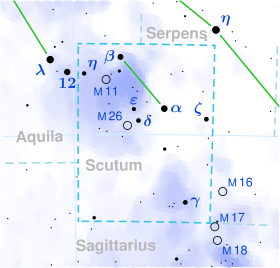Top Qs
Timeline
Chat
Perspective
Beta Scuti
Star in the constellation Scutum From Wikipedia, the free encyclopedia
Remove ads
Beta Scuti, Latinized from β Scuti, is a binary star system in the southern constellation Scutum. Based upon an annual parallax shift of 4.85 mas as seen from Earth,[2] it is located approximately 670 light years from the Sun.
Remove ads
Characteristics
Summarize
Perspective
This is a spectroscopic binary with an orbital period of 2.3 years and eccentricity around 0.35.[10] The secondary is about 3.3 magnitudes dimmer than the primary and estimated as type B9 based on the flux of far-ultraviolet radiation.[11]
The primary component has an apparent visual magnitude of +4.22 and is radiating about 1,315 times the luminosity of the Sun from its outer atmosphere at an effective temperature of 4,951 K.[7] This yellow-hued star is a G-type bright giant with a stellar classification of G4 IIa.[4] Its angular diameter was measured at 2.121 milliarcseconds by the Navy Precision Optical Interferometer, which gives it a physical radius of approximately 49 R☉ at the estimated distance.[7]
The secondary was directly detected with a magnitude difference of 3.6 at a separation of about 17 milli-arcseconds using observations from the Navy Precision Optical Interferometer.[12] This detection was significant as observations with the Hubble Space Telescope which indicated a companion star was present were not definitive.[13] With an orbit and a parallax the sum of the masses of the two stars can be determined via a dynamical parallax.[14] This eventually can yield a precise mass for the evolved giant primary star.
Beta Scuti was a latter designation of 6 Aquilae.[15]
Remove ads
References
Wikiwand - on
Seamless Wikipedia browsing. On steroids.
Remove ads

